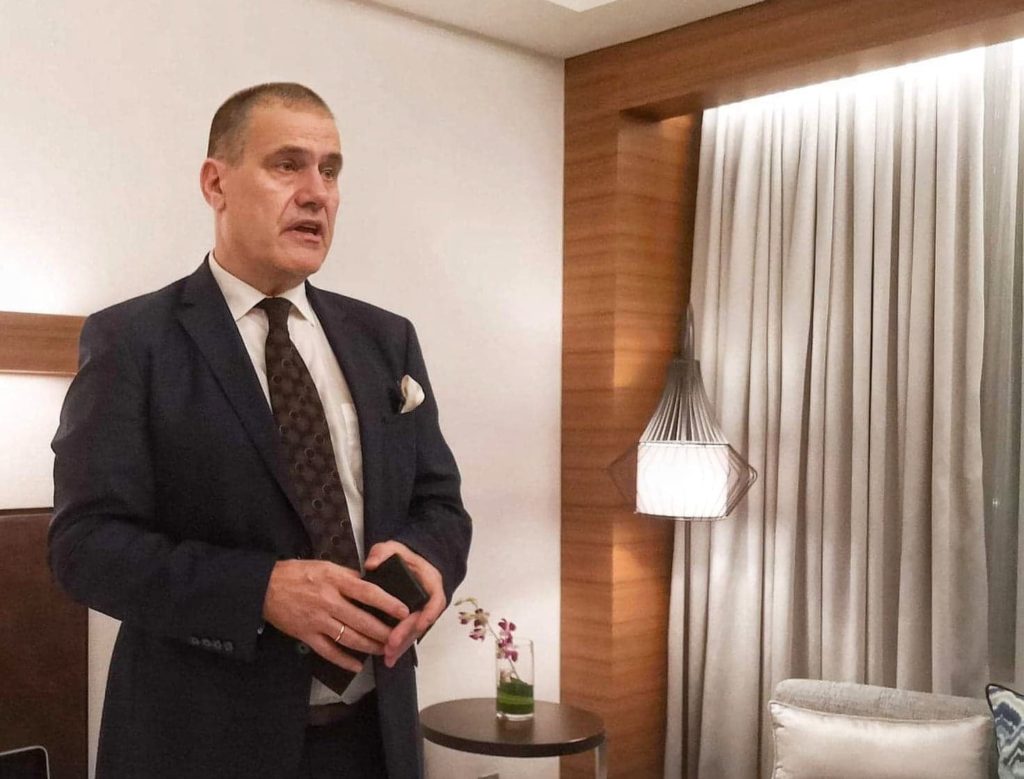
Stephan Sieberg, Radisson Blu Hotel Cebu’s general manager. CDND photo/Doris Mae Mondragon
Radisson Blu Hotel Cebu continues to evolve and stay in step with today’s dynamic market by embarking on a two-year P400 million face-lift of their business class rooms.
Stephan Sieberg, Radisson Blu Hotel Cebu’s general manager, said the group was spending at least P400 million to modernize 400 business class rooms, or an investment of P1 million for each room.
Sieberg said that with the completion of the first phase of the two-year renovation program, at least 55 of the rooms would be ready to welcome guests.
“The biggest change is the arrival experience. When you open the door. you have this dull and dark room we had before and then it was really the goal, how can we make it more inviting,” he said.
“Sooner or later a product will just be worn out and with the high occupancy, and because the building was 8 years old, we were forced to do something. Then the old bathrooms, it’s of hygienic and aesthetics reasons that customers are telling us. There it all started,” he added.
He said the renovation program, which is funded with purely internal cash accumulated by the hotel sales, involves improving the bathroom, retrofitting and upgrading the IT systems.
“Whatever the hotel have, we are reinvesting in our own business,” he said.
Full operation
Even with the ongoing renovation works, Radisson Blu has maintained its reputation on luxury and hospitality as it gained thousands of recommendations online.
The hotel was also tagged by TripAdvisor Philippines, an online travel site, as one of the Top 10 Best Hotels in Cebu City.
“The hotel is in full operation. There is no disturbance and that was the biggest challenge. We have proven with the first batch (of renovation) which started last year with the first three floors. If you look at Trip Advisor, we’re still at number 1 even with the renovation. Guest comments are still at very high levels. So it looks like we’ve managed very well,” he said.
The first phase of the renovation started in June last year and at least 55 rooms are now operational.
The renovation is already at the second phase with 70 more rooms expected to to be operational by the end of March.
The renovation work is set to be completed on February 2020, although, Sieberg said they are trying to move it forward by December this year, or that is two months ahead of the target schedule.
Price increase
Sieberg pointed out the continuous upswing over the last five years which had caused the high price point in the hotel industry in Cebu.
After the renovation, a 15 percent increase in the prices of the rooms is being considered by the hotel management.
However, Sieberg said the pricing would also be dynamic since they would still have to sell the remaining old rooms by December.
“It’s a mixed (one) because Cebu has picked up tremendously in 2018 already,” he said.
“There’s no cut-off day. Normally when you close down, there’s the opening day. You come out with new prices. But we have it staggered because we still have old rooms in December this year, and we’re only in February now, so we need to still sell old rooms in a way and we have 10 months. So it’s a mixed (marketing of the rooms),” he said.
Target markets
With the remarkable growth in tourism industry and the booming infrastructure in Cebu, Sieberg said the renovation would also prepare them for competitors.
The company, Sieberg said, is looking into new markets as well.
“We are looking into Taiwan, which is a small market. But at the end of the day, it’s a question of visa, who could easily travel here, and for the huge congress center, the MICE (Meetings, Incentives, Conference, and Exhibits) segment which is very important to us, it’s not purely hotel rooms,” he said,
Aside from foreign tourists and businessmen, Sieberg said the company was also eyeing the local businessmen as target market.
“There’s a lot of local business here and we’re absolutely interested,” he said pointing out the increasing market demand in the Visayas region.
“A lot of traffic is also coming from other cities like Davao. But at the end of the day, it’s really about accessibility,” Sieberg said.